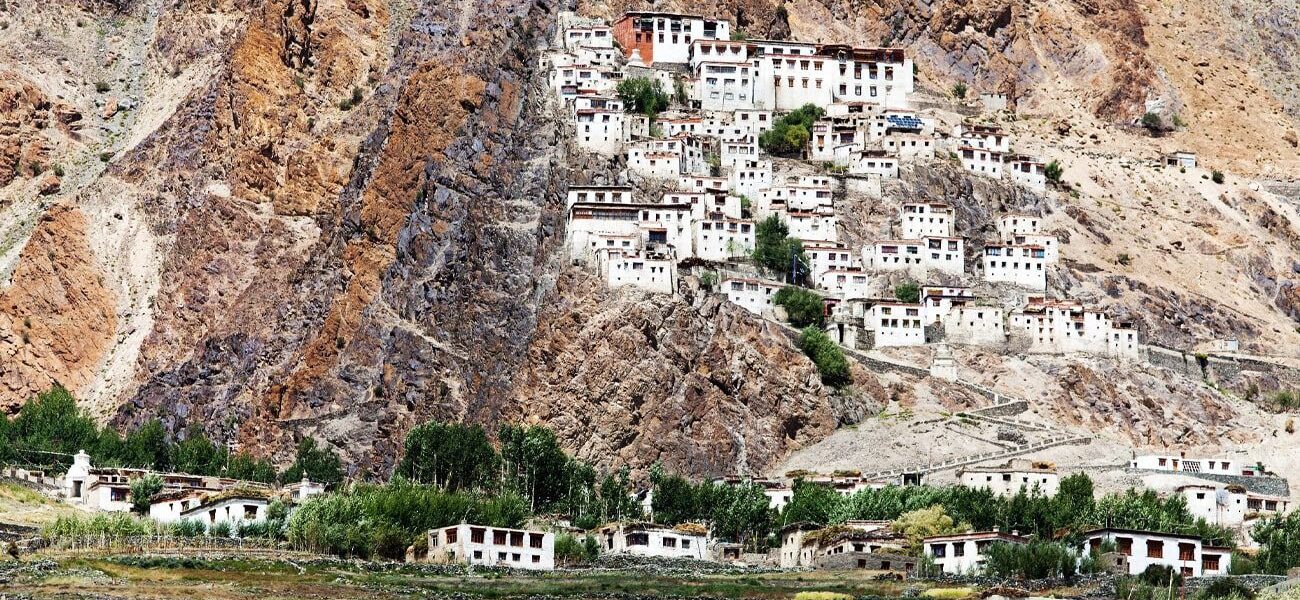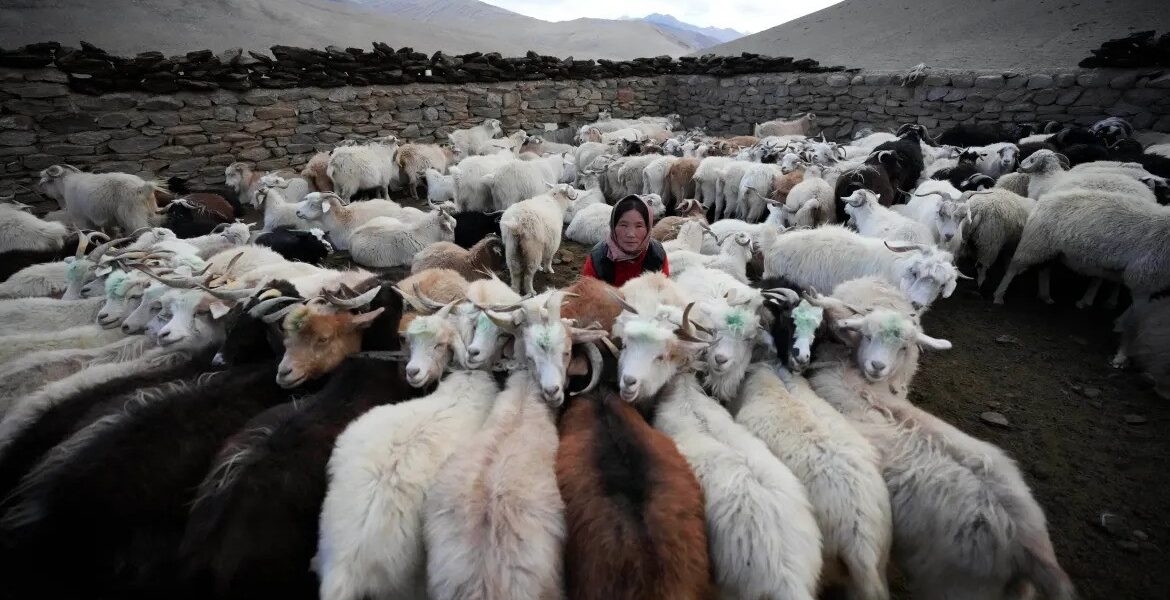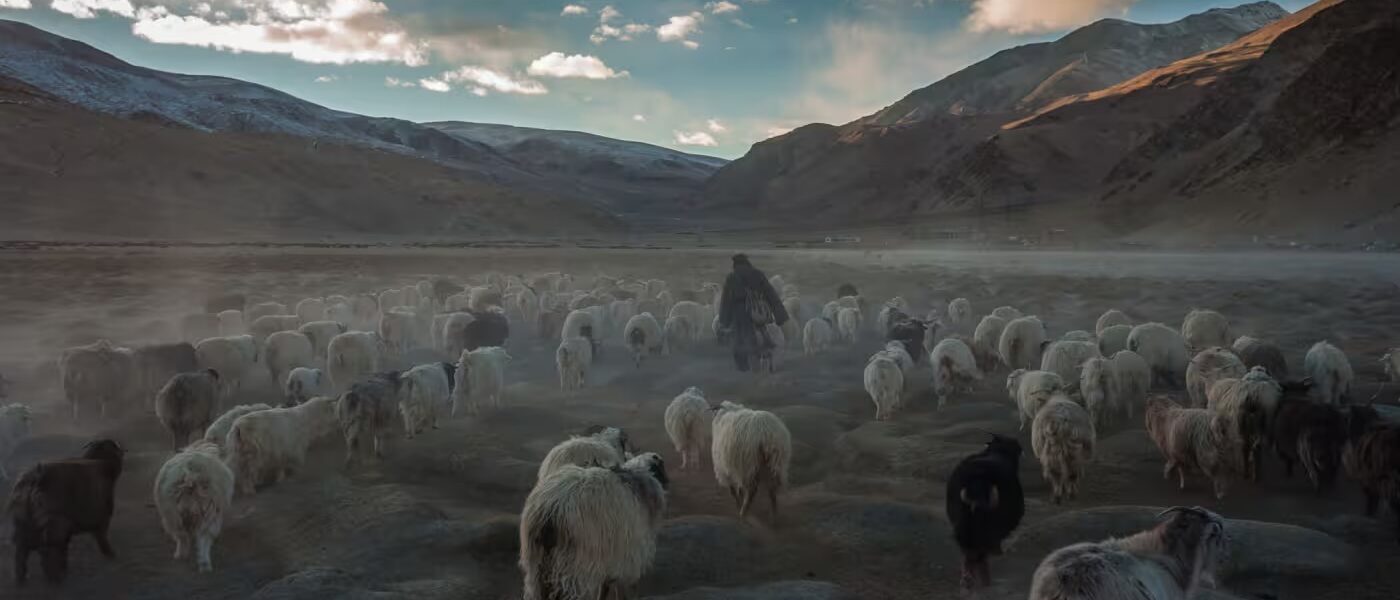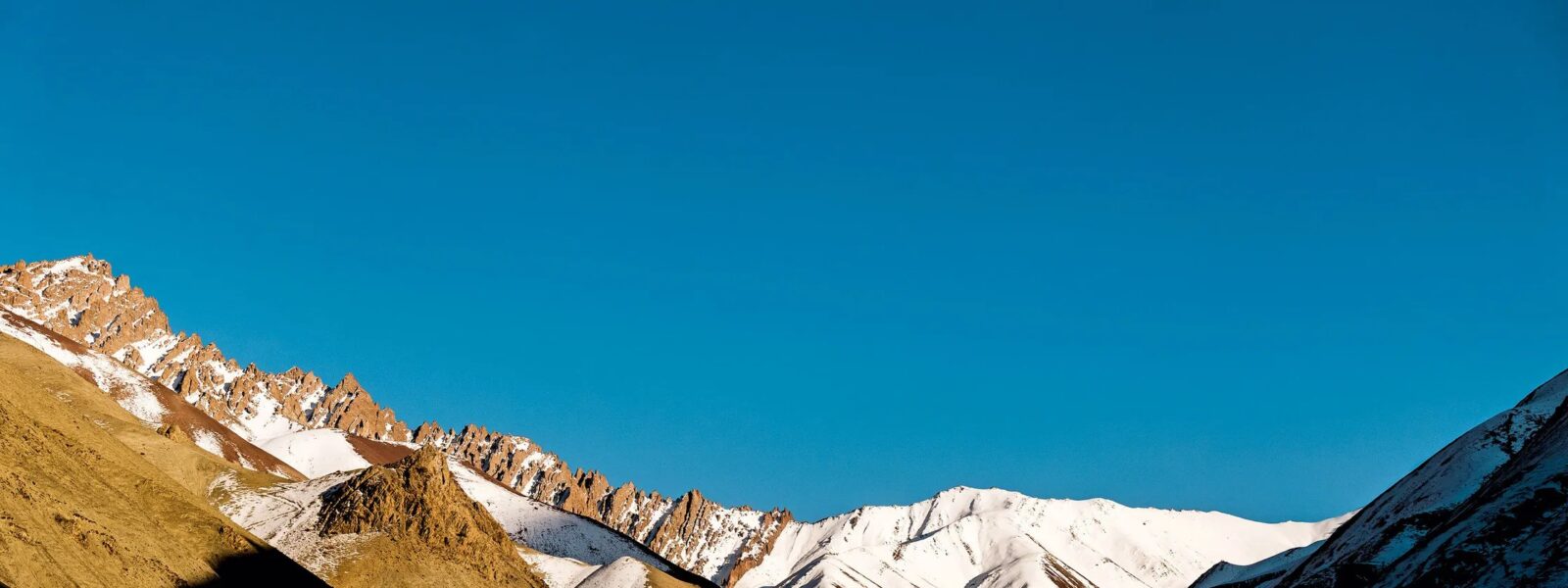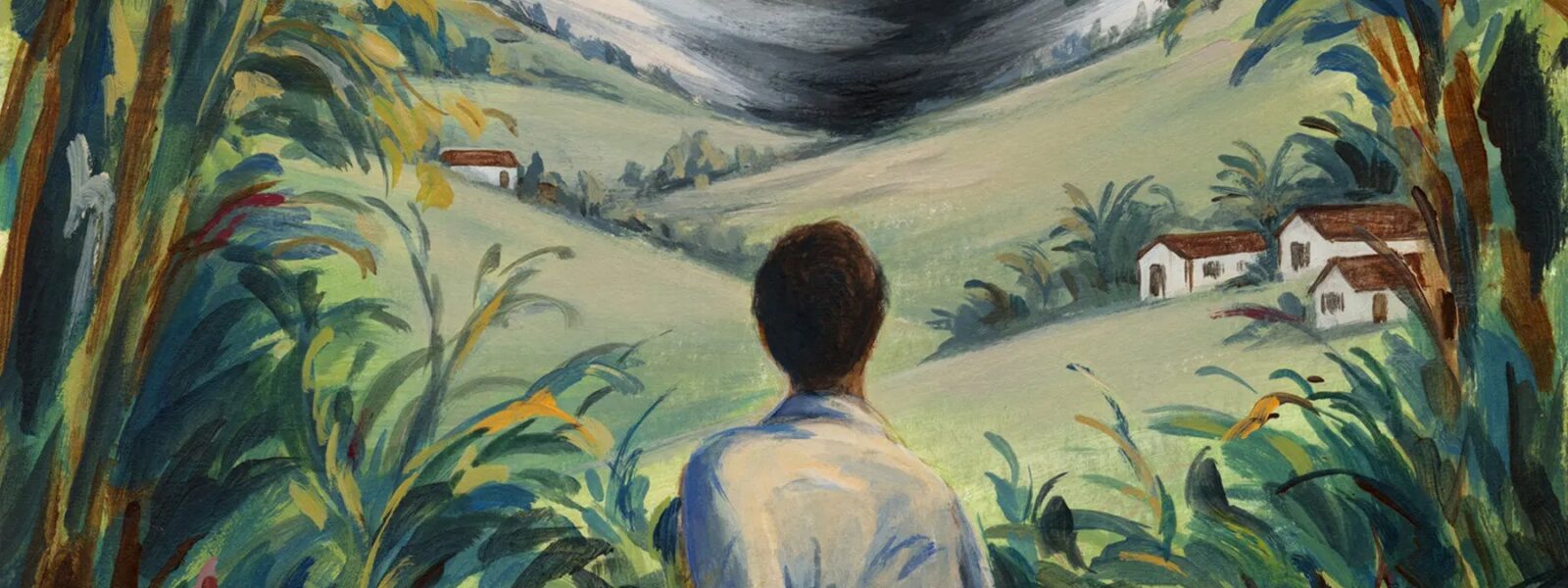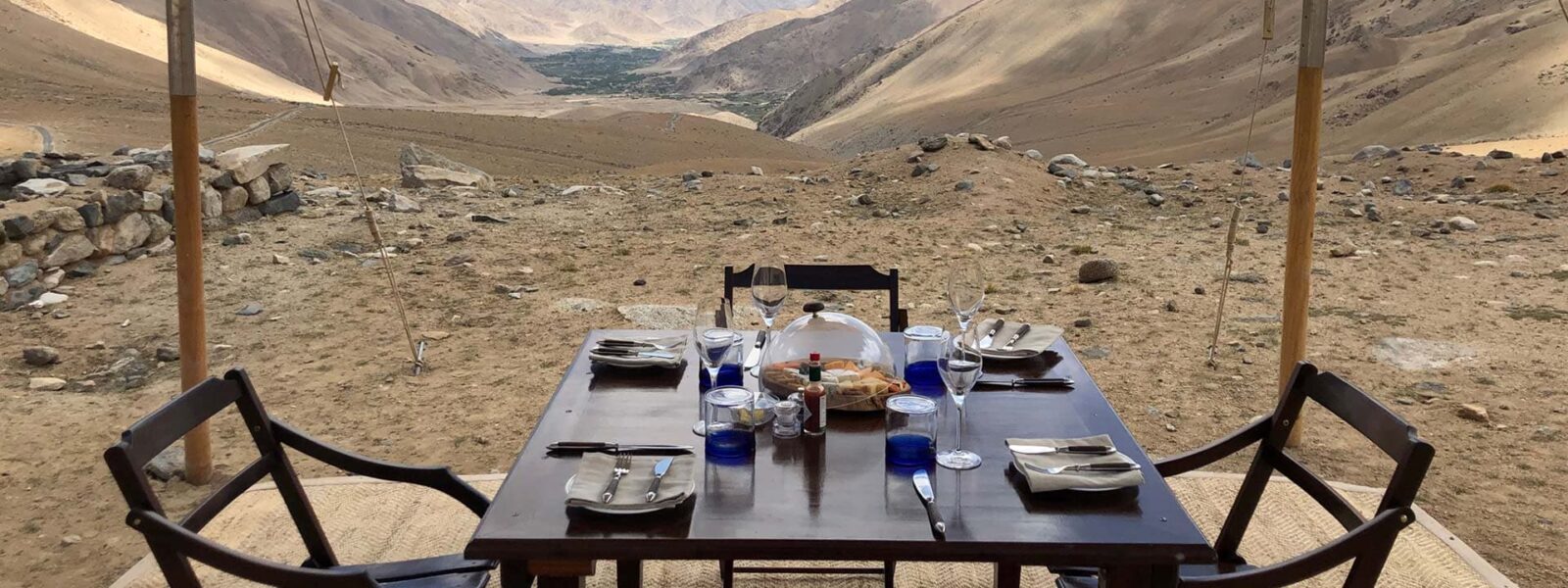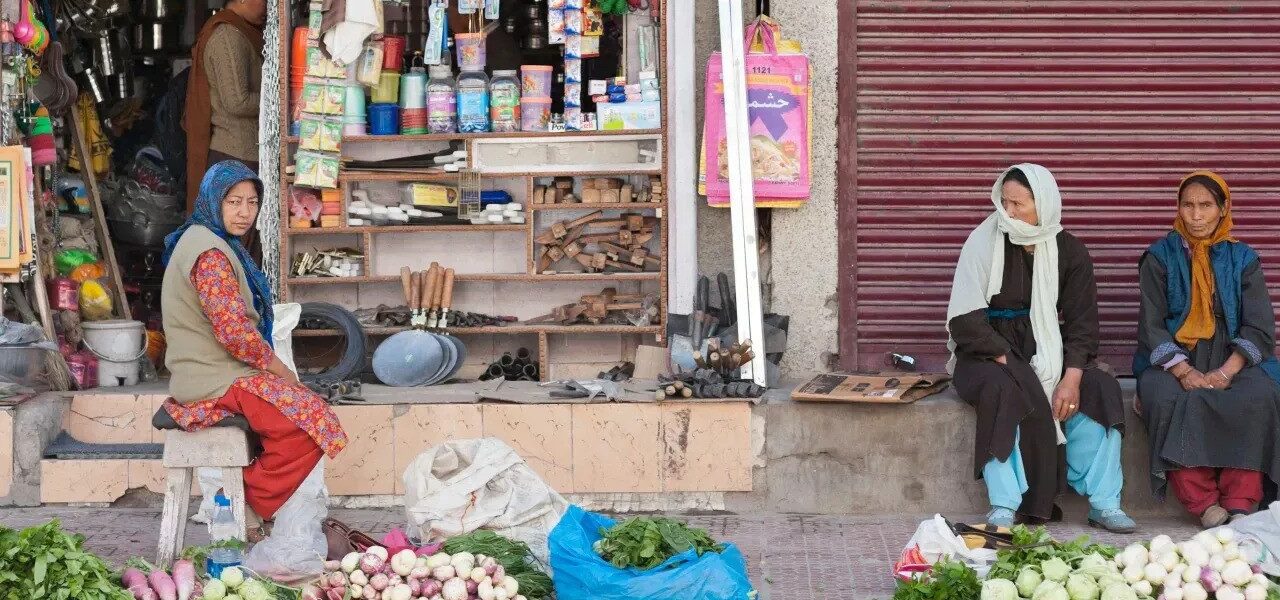Introduction to Karsha Monastery
Perched dramatically on the slopes above the Stod River, just 9 kilometers from the town of Padum, Karsha Monastery is not just the largest monastic complex in Zanskar — it is the spiritual heartbeat of the entire valley. With whitewashed buildings cascading down the mountainside and fluttering prayer flags catching the mountain breeze, the sight of Karsha Gompa is enough to stop any traveler in their tracks.
Founded by the revered Buddhist teacher Phagspa Sherab, this ancient complex belongs to the Gelugpa (Yellow Hat) order of Tibetan Buddhism. Home to around 90 monks, Karsha is more than a place of worship — it is a living institution where tradition, meditation, and monastic education converge amidst the raw beauty of the Himalayas.
For those seeking a deeper understanding of Ladakh’s spiritual fabric, Karsha offers a rich window into Buddhist rituals, teachings, and everyday monastic life. Its commanding view over the Padum valley only enhances the experience — the landscape stretching beneath your feet is as meditative as the chants echoing from the temple walls.
The atmosphere here is otherworldly. In the early morning, the air carries the sound of chanting monks and softly ringing bells. By late afternoon, golden light bathes the white gompa walls in a dreamlike glow. Visitors often report a sense of profound stillness, the kind of peace that lingers long after you’ve left.
But Karsha is more than serene—it is active. Annual festivals like the Gustor, where masked Cham dances are performed, bring bursts of color and spiritual energy to the usually tranquil halls. These events aren’t just performances for tourists—they are sacred rituals with centuries of cultural meaning.
If you’re planning a journey through the Zanskar Valley, Karsha Monastery isn’t just a recommended stop—it’s an essential one. Whether you’re a photographer chasing that perfect shot of layered white stupas, a cultural traveler curious about Himalayan Buddhism, or a seeker in need of silence, Karsha welcomes all with the same quiet dignity.
In the next section, we’ll step deeper into the story of Karsha’s founding and explore the life of Phagspa Sherab, whose vision still guides the monastery’s path to this day.
Historical Background and Founding
To truly understand the soul of Karsha Monastery, one must travel back through time—beyond the prayer wheels and flickering butter lamps, into the spiritual roots of the Zanskar Valley itself. Karsha Gompa owes its origins to a visionary monk named Phagspa Sherab, a devoted follower of the Gelugpa tradition, who laid the foundation for this sacred institution centuries ago.
The exact date of its founding is unclear, lost in the folds of Himalayan oral history, but what remains unquestioned is its influence. Over generations, Karsha evolved into the largest and most significant Gelugpa monastery in Zanskar, shaping not only the region’s religious practices but also its education and cultural identity.
Phagspa Sherab was not just a religious figure — he was a teacher, a healer, and a unifier. He is said to have traveled extensively through the valleys and passes of Ladakh, planting spiritual seeds that still bloom today in the form of rituals, chants, and sacred art. Karsha was his crown jewel — a monastic stronghold where young monks would be trained, sacred texts preserved, and the teachings of the Buddha kept alive in this remote Himalayan frontier.
The monastery’s connection with the Gelug school of Tibetan Buddhism also placed it within a wider spiritual network, linking it to prominent centers of learning in Tibet and Ladakh. This ensured a steady flow of teachings, practices, and monastic visitors, which helped Karsha flourish not just in isolation, but as part of a greater Buddhist world.
Beyond doctrine, Karsha has long served as a protector of local communities. During times of political upheaval or natural hardship, the monastery provided refuge and guidance, reinforcing its role not only as a religious institution but as a pillar of resilience and continuity in the harsh mountain environment.
Its hilltop location wasn’t chosen by chance. According to legend, Phagspa Sherab selected the site after a vision — a spiritual prompting that told him this was the place where the teachings would endure. Today, standing among the crumbling stupas and weathered prayer stones, it’s easy to believe that vision still pulses in the wind.
In the following section, we’ll explore the architectural grandeur of Karsha — a labyrinth of history etched into the cliffs, shaped by generations of faith and Himalayan craftsmanship.
Architectural Marvels of Karsha Monastery
Built like a cascading fortress on a rocky hill overlooking the fertile Padum Valley, Karsha Monastery is a striking example of traditional Ladakhi and Tibetan monastic architecture. The complex is not a single structure but a labyrinth of interconnected temples, residential quarters, prayer halls, and meditation caves, each added over centuries by successive generations of monks and spiritual patrons.
From a distance, the monastery resembles a white stone avalanche, spilling down the slope in tight, organic clusters. Up close, the details reveal a sophisticated architectural response to the harsh Himalayan environment. Thick stone walls provide insulation against the bitter winters, while small, strategically placed windows control light and retain warmth. The rooftops, flat and layered, are often used for drying food or hosting ritual gatherings during warmer months.
At the heart of the complex is the Dukhang, or main assembly hall, which is often the spiritual and communal center of monastic life. Inside, walls are adorned with ancient frescoes and thangka paintings depicting the lives of the Buddha, protector deities, and historical lineage holders of the Gelug tradition. The air inside is scented with centuries of burning butter lamps and incense, and the soft glow creates an ambiance of reverence and continuity.
One of Karsha’s architectural highlights is its elevated stupas, or chortens, which are scattered across the slopes like silent sentinels. These reliquary structures hold sacred texts, relics, and the ashes of respected monks. Many are intricately painted in traditional ochre and white hues, and their forms follow the ancient symbolism of Buddhist cosmology.
Also notable is the network of narrow, winding stairways and hidden passageways that connect the various buildings. As you walk through the monastery, you’ll encounter small meditation rooms tucked into cliffside nooks, open courtyards where monks gather under fluttering prayer flags, and raised balconies offering panoramic views of the Zanskar range.
The overall layout of the monastery, though appearing chaotic, follows a deep spiritual logic. Higher buildings — especially those housing the main shrine rooms — are always situated above residential quarters, reflecting the hierarchical relationship between sacred space and everyday life.
Karsha’s architecture is not simply about form—it is a physical manifestation of devotion, community, and adaptation. Each stone, stair, and mural tells a story, preserved against the ravages of time and weather. Visitors often leave in awe not only of the natural setting but of the ingenuity and spirit that built and sustained such a structure in one of the most remote corners of the Indian Himalayas.
In the next section, we’ll step inside this living institution to meet the monks and understand their daily rhythms and rituals within these sacred walls.
Life Inside Karsha Monastery
While the towering walls and ancient murals of Karsha Monastery impress at first glance, it’s the quiet rhythm of monastic life within that leaves a lasting impact. Unlike abandoned ruins or tourist-only attractions, Karsha remains a living, breathing spiritual community, home to nearly 90 monks who follow a disciplined daily routine rooted in Buddhist teachings.
The day begins before sunrise. A bell sounds through the valley, echoing softly across the still air. Monks, some as young as ten, gather in the Dukhang (assembly hall) wrapped in maroon robes, chanting from sacred texts in deep, melodic tones. These early morning pujas (prayers) are the heart of monastic life — a time to reflect, recite, and connect with the Dharma before the world awakens.
After the morning chants, younger monks attend scripture classes, led by senior Lamas. Here, they study Buddhist philosophy, Tibetan grammar, rituals, and logic. Education at Karsha is rigorous but holistic — combining memorization with debate, silence with service. Between lessons, monks perform daily chores: cleaning prayer halls, preparing butter lamps, and fetching water in copper pots from nearby springs.
Meals are simple and shared. Tsampa (roasted barley flour), butter tea, lentils, and rice form the staple diet. These are served in communal dining halls where hierarchy is observed but camaraderie runs deep. Despite the austerity, laughter often echoes through the stone walls, especially among the younger novices.
The afternoons are quieter. Some monks meditate in solitary retreat rooms tucked into the higher corners of the monastery. Others perform ritual offerings, care for the relics, or receive villagers who climb up from Padum seeking blessings, healing, or counsel. Karsha serves not just as a center of prayer but as a pillar of community life in this remote Himalayan valley.
Ceremonial rituals mark the monastic calendar. The Karsha Gustor Festival, held in summer, brings the monastery alive with masked Cham dances, spiritual blessings, and large gatherings. But even on ordinary days, one can witness sacred rituals — fire pujas, butter lamp offerings, and chanting that seems to merge with the wind itself.
Visitors to Karsha often remark on the contrast between the remote silence of its location and the warmth of life within. You are not just observing history—you are witnessing tradition in motion. Respectful travelers may be invited to sit quietly during prayer or share tea with a monk, providing a rare chance to glimpse a way of life unchanged for centuries.
In the next section, we’ll guide you through planning a visit to Karsha Monastery — the best times to come, how to get there, and what to expect when stepping into this timeless world.
Planning Your Visit to Karsha Monastery
Reaching Karsha Monastery has become more accessible than ever before, thanks to the recent opening of new motorable roads connecting the remote Zanskar Valley with central Ladakh. What was once a multi-day trek or a rugged off-road adventure can now be done by car — though the journey remains as scenic and spiritually charged as ever.
From Leh, there are now three major road options to reach Padum, the base town for visiting Karsha Monastery:
1. Lamayuru – Singay La – Lingshed – Padum (New All-Weather Road)
This recently completed route offers the most direct and scenic access to Zanskar. Starting from Lamayuru, one of Ladakh’s most famous monasteries, the road crosses the high-altitude Singay La Pass before descending into the Zanskar Valley. It’s now possible to drive from Lamayuru to Padum in about 8–10 hours, depending on road conditions. The route is fully motorable and suitable for 4×4 vehicles and well-maintained SUVs.
2. Chilling – Shinkun La – Padum (Under Development/Seasonal)
A newer road under progressive development links Chilling (near the starting point of the Chadar Trek) to Padum via Shinkun La. Though not yet complete as an all-season route, many sections are already accessible during the warmer months. This route is ideal for adventure travelers and offers breathtaking views of untouched valleys.
3. Kargil – Suru Valley – Rangdum – Penzi La – Padum (Traditional Route)
The classic route to Padum runs from Kargil via the Suru Valley and crosses the stunning Penzi La Pass. This road is open mainly from June to October and takes about 12–14 hours to drive. It remains a favorite for those wanting to explore remote villages, Rangdum Monastery, and the surreal Drang Drung Glacier along the way.
Once you reach Padum, Karsha Monastery lies just 9 kilometers away on the opposite side of the Stod River. The drive is short but spectacular, winding past barley fields, suspension bridges, and rural hamlets.
Best Time to Visit Karsha Monastery
The ideal window for visiting Karsha is from **late June to mid-October**, when all access roads are open and the weather is stable. This period also coincides with the monastery’s annual festival season, including the Karsha Gustor in July or August (dates vary by lunar calendar). During these months, you can enjoy clear skies, cultural rituals, and relatively warm days — though nights can still be chilly.
Permits & Travel Essentials
No special permits are required for Indian citizens to visit Karsha or Padum. Foreign nationals typically do not require an Inner Line Permit for Zanskar, though it’s always advisable to carry a copy of your passport and visa at checkpoints. You’ll also want to carry enough cash, as ATMs and card services are extremely limited in the region.
Transportation Tips
Hiring a private vehicle from Leh or Kargil is the most reliable option, especially for flexibility and comfort. Public transportation to Padum exists but is sparse, and schedules can be irregular. If you’re planning a trek (such as to Phuktal or Lingshed), Karsha makes an excellent base for acclimatization and spiritual grounding before setting off.
In the next section, we’ll explore what else you can discover nearby — from ancient monasteries to dramatic landscapes that will leave you breathless.
Nearby Attractions in Zanskar Valley
While Karsha Monastery may be the spiritual heart of the Zanskar Valley, it is far from the only site worth visiting. The region is dotted with ancient monasteries, royal ruins, glacial valleys, and timeless villages — each adding a unique thread to the cultural and natural tapestry of Zanskar.
Stongdey Monastery (approx. 18 km from Padum)
Second in size only to Karsha, Stongdey Monastery stands proudly on a ridge overlooking the valley and offers sweeping panoramic views. Belonging to the Gelugpa order, this gompa is home to over 60 monks and features vibrant wall paintings, calm courtyards, and a meditative atmosphere. A visit here complements the experience of Karsha and deepens your understanding of the monastic network in Zanskar.
Zangla Palace and Nunnery (approx. 35 km from Karsha)
Travel northeast along the Zanskar River and you’ll arrive at Zangla, once the seat of a regional king. The ruined Zangla Palace still watches over the valley like a sentinel from another era. Nearby is a small nunnery where women continue Buddhist practice with quiet resilience — a powerful reminder of the diversity within Ladakhi spiritual life. The route to Zangla also rewards travelers with dramatic gorges and traditional Zanskari homes.
Sani Monastery (approx. 7 km from Padum)
Among the oldest religious sites in Ladakh, Sani Gompa is unique for its location on the flat plains rather than a mountain slope. It belongs to the Drukpa Kagyu lineage and features the ancient Kanika Chorten — believed to date back to the Kushan period. Sani also hosts a vibrant annual festival in late summer, where villagers and monks gather for masked dances and prayer ceremonies.
Phuktal Monastery (via trek or drive + trek)
One of the most visually stunning monasteries in the entire Indian Himalayas, Phuktal Gompa is built into the mouth of a cave high above the Tsarap River. Though it requires a multi-day trek (or drive to the trailhead near Cha village followed by a short hike), the journey is worth every step. The monastery feels like a living sculpture, where meditation halls grow out of stone and the silence is deep and ancient.
Drang Drung Glacier (en route via Penzi La)
If you arrive in Zanskar via Kargil and Penzi La, be sure to stop at the viewpoint overlooking the Drang Drung Glacier. This vast river of ice is one of the largest glaciers in Ladakh and offers a surreal contrast to the monastery-dotted valleys below. It’s a stark reminder of the wild, elemental forces that shape life in these highlands.
Together, these destinations create a rich circuit of exploration around Karsha Monastery. Whether you’re tracing ancient spiritual paths, admiring Himalayan architecture, or simply absorbing the solitude of Zanskar’s dramatic landscapes, each stop adds another layer to your journey.
In the final section, we’ll reflect on what makes Karsha not just a place to visit — but a place to remember.
Final Thoughts: Why Karsha is a Must-Visit in Zanskar
Karsha Monastery is not simply a point on a map — it is a living chapter in the story of Zanskar, where geography, faith, and heritage converge in a setting of unforgettable beauty. Whether you arrive through the high passes of Singay La, the winding road from Kargil, or the newly opened route from Lamayuru, the journey to Karsha is a pilgrimage in its own right.
At Karsha, the line between the sacred and the everyday blurs. It’s where morning chants echo across barley fields, where young monks debate philosophy under fluttering prayer flags, and where the stones under your feet hold the warmth of centuries of devotion. Unlike more famous sites that risk becoming relics of the past, Karsha remains deeply alive — rooted in ritual, education, and community service.
For cultural travelers, the monastery offers rare insight into the heart of Zanskar’s identity. It is a place to witness Buddhist traditions preserved against time, to see how remote communities maintain their rhythm of life in harmony with their environment. You are not just a visitor here — you are a respectful guest in a living sanctuary.
For spiritual seekers, Karsha invites reflection. There is a stillness in the air, a kind of mountain silence that cleanses the noise of the outside world. Whether sitting quietly in the prayer hall or watching monks light butter lamps at dusk, the experience leaves a quiet imprint on the soul.
And for those simply seeking awe — Karsha delivers. The views of the Padum Valley below, the intricate murals inside its temples, the harmony between built structure and natural form — all combine to create a sense of place that stays with you long after you descend the hill.
In a region that’s still off the radar for most mainstream tourists, Karsha Monastery is a shining example of why Zanskar deserves attention: not just for its landscapes, but for its spiritual legacy and enduring culture. It reminds us that some journeys aren’t just about the destination — they’re about being present, listening deeply, and allowing ourselves to be transformed.
So if you find yourself tracing the ancient paths of Ladakh, make space for Karsha in your journey. You won’t just find a monastery — you’ll find something quietly eternal.

